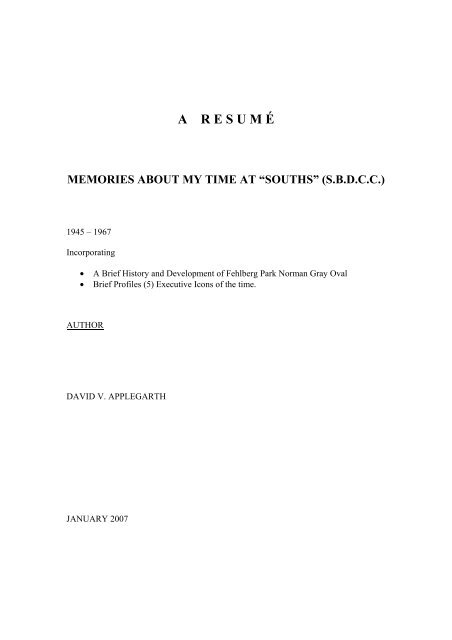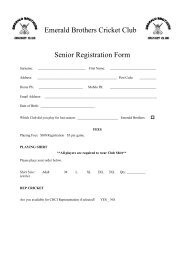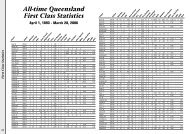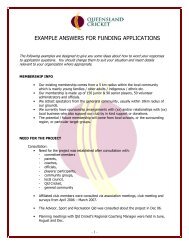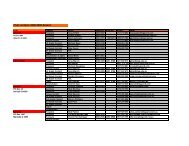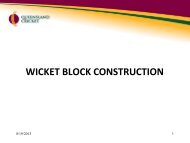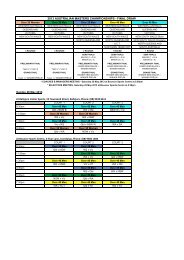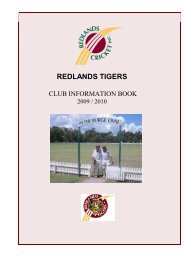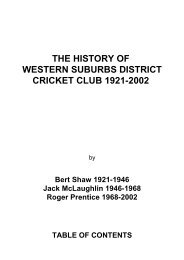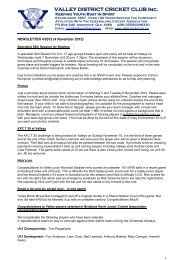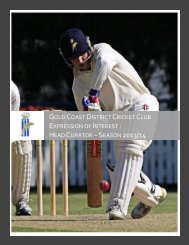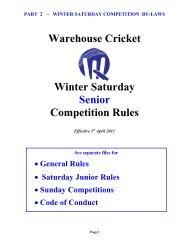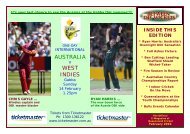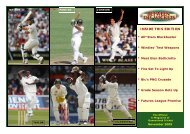A R E S U M Ã - Queensland Cricket
A R E S U M Ã - Queensland Cricket
A R E S U M Ã - Queensland Cricket
Create successful ePaper yourself
Turn your PDF publications into a flip-book with our unique Google optimized e-Paper software.
AR E S U M ÉMEMORIES ABOUT MY TIME AT “SOUTHS” (S.B.D.C.C.)1945 – 1967Incorporating• A Brief History and Development of Fehlberg Park Norman Gray Oval• Brief Profiles (5) Executive Icons of the time.AUTHORDAVID V. APPLEGARTHJANUARY 2007
2FORWARDI believe that I am privileged in my life to have been a Player, Executive, Club Captainand Life member of this wonderful <strong>Cricket</strong> Club “Souths”.Having been a guest at the official opening of the refurbished John McKnoultyClubhouse on Sunday 5 th November 2006 and talking with colleagues of my era andbeyond I thought that, probably being the longest standing Life member (appointed 1964)still alive, I should commit to paper some factual memories of my playing days,administration duties and more particularly issues and occurrences as they relate toFehlberg Park and the Norman Gray Oval. In discussion with President Sal VASTA I ampleased that he also thought this would be a good idea.I have concluded my Resumé at 1967 because then I was transferred away from Brisbanein my business career and was generally on the move until the mid 1970’s when Ireturned to Brisbane. My interest in this great Club has never waned and I thank mostsincerely those who followed me for the work they have continued to perform and themilestones achieved up to another significant event witnessed on 5 th November 2006. Ihope that others of my colleagues and friends at Souths may also commit theirexperiences to paper and in particular the years leading to the planning and erection ofthe original John McKnoulty Clubhouse and improvements leading to the wonderfulOvals and Practice facilities which now surround it.I am very aware that with Clubs like ours people tend to do their jobs and move onhowever I believe that History and memories are important ingredients to continuebuilding our “Souths” culture and that of its future leaders.May I suggest to anyone capable of writing a few paragraphs, don’t miss youropportunity to do so otherwise your experiences will be lost in time.Best wishes to all at Souths for a bright future.RegardsDavid ApplegarthJanuary 2007
3A RESUME – MEMORIES ABOUT MY TIME AT SOUTHS (S.B.D.C.C.)1945 – 1967These are some of my memories:-1945 – 1950 - My early years playing <strong>Cricket</strong>In late 1945 at age 11 years I was selected from Yeronga State School to try out forSouths Primary Schools <strong>Cricket</strong> team which played in the Q.C.A. competition. We triedout on concrete wickets in Musgrave Park South Brisbane.Jack HOELSCHER was the man running the show and of course I was to find out he wasCoach, Selector, Hon. Secretary of the Club, Q.C.A. Scorer amongst many other thingshe did for cricket. Mr Hoelscher as we knew him was badly crippled from youth andmoved around with the aid of crutches. He had a great cricket brain.I was selected a couple of times in 1945 as 12 th man for the schoolboys team.In 1945 after peace was declared in World War II Souths home ground, as it was beforethe war, was Davies Park near the Brisbane River at West End. It was on army campduring the war and afterwards the pitch and ground were in only reasonable shape. SoSouths ‘A’ Grade team which included Harry Pegg, Bob Young, George Gooma, VicMottershead, Des Hansen and others played at “the Gabba” ground which had beengranted to Souths by the then <strong>Cricket</strong> Ground Trust. The lower grades played on atDavies Park.The Primary schools team which I joined played on various other small grounds aroundBrisbane at High Schools and Grammar schools after they had finished their matchesmainly on Saturday mornings.In 1946 as the older players moved up I was able to make the team full-time.Outstanding players for Souths then were Max Robins, Ron Archer, Brian O’Sullivan,Ian Way, Gordon Jones and Ron Burke.Schools in the Souths District who contributed were:-West End, Yeronga, South Brisbane Intermediate and Moorooka.In these days we had a man as our Captain and Coach, this job fell to Rhuben NICOLwho went on to be appointed a Life member of the Club, a most generous man.
41947 saw Ron Archer and myself selected to open the batting for <strong>Queensland</strong> Schoolboysin a Carnival held in Brisbane. 1947 was also the 50 th Anniversary year of the formationof our great Club “Souths”. As a junior I attended the main function dinner held at WestEnd School of Arts Hall in Boundary St. West End. Mental pictures of this function andsome activities of the night are still clear in my mind. In 1997 I also attended the 100 thAnniversary Dinner at Mercure Hotel – North Quay hosted by Ian Seib as President.In 1948 Ron Archer and I again played for <strong>Queensland</strong> Schoolboys team in the Carnivalheld in Melbourne. Around this time a new grade was introduced by the Q.C.A. called“Intermediate Grade” designed for 14 and 15 year old players to play against each otherat a higher standard of cricket thus making the step to further higher grades more smoothwhen that occurred.By this time 1948/49, being at High School, I was required to play for B.S.H.S. onSaturday mornings and Souths Intermediate Grade in the afternoons.During this period and by the end of 1949 I was able to progress my game with the helpand guidance of Souths people to become a 1 st XI player at B.S.H.S. and in 1949 a G.P.S.XI representative.B.S.H.S. won its first G.P.S. “A” Grade <strong>Cricket</strong> Premiership in 1949. In 1999 some of usplayers of 1949 celebrated at a 50 year reunion dinner at the <strong>Queensland</strong> <strong>Cricket</strong>ers Club.My progression as a cricketer was I am sure generated by the interest and opportunitythat the great S.B.D.C.C. provided for me and many other boys of this time.In 1950’s Souths still called Davies Park home even though “A” Grade was played at theGabba. Presidents days were held each year at Davies Park, memorable days they werelike the ones held nowadays.As lads, in these days, we often went on Saturday afternoons to “the Gabba” to watch thelikes of Harry Pegg, George Gooma, Bob Young and Others ply their cricket skills forthe club. All of these ventures being learning experiences for us.I commenced work in 1950 as an Insurance Clerk in Brisbane.Later in 1950 Ron Archer and I, at the age of 16 years, were selected in Souths “A”Grade team. The selectors of the day including Jack Hoelscher must have had faith inour ability and future as class players of the future. I hope that the records show wedidn’t let them down. This meant we played our home games at “The Gabba” quite astart for two teenagers. Our first Captain was Bill Brown so we were gratified at a youngage to have played with such stars in our early years of “A” Grade.
5Other players in 1950’s teams were:-George Gooma (V. Capt) Ley Sanders, Bob Young, Cyril Smith, Arthur McIllwain,George Jeavons, Wally Grout, Max Robins and Ken Archer. Later Wally Grout whogrew up living in the South Brisbane area had to move and play with Toombul becausefollowing his marriage he lived at Wavell Heights in the Toombul District.District cricket boundaries were in full swing, you had to play in the district where youlived. Max Robins and Don Grinwade did a short stint with Valleys then becausefollowing their marriages they lived in Valleys territory.Souths district took in the Southern Suburbs coming away from the city of Brisbanebounded by Brisbane River on the West and Logan Rd. on the east. A large andexpanding area of Brisbane.For all my boyhood life I lived at Annerley and when married in 1955 at Moorooka bothwithin Souths district.Growing with the Club I loved (Becoming more than just a player)In my early years at Souths I was always conscious of fund raising activities going onaround me without being asked to make much of a contribution.Around the time I went to live at Moorooka, Harry Petersen and Fred Price started aGrocery Wheel at Moorvale Shopping Centre on Saturday mornings to raise funds for theClub. The venture went on for many years with players being rostered to work 1 week inevery 3 or 4. Harry Petersen was later honoured with Life membership of the Club. JohnPrice son of Fred Price was a prominent player and worker for Souths and is an existinglife member.Then in Bill Lockwood’s time as Honorary Secretary one Graham Pearsen a neighbour ofBill’s at Tarragindi came on the scene as Fund Raising Chairman. Graham and his teamplus rostered players went to Chardons Corner Hotel each Saturday morning for “ChookRaffles”. Later on of course the Club had its weekly night of “Bingo” at Chardons Hotelcourtesy of the Burton family as publicans.Looking back now one appreciates how much assistance these fund raising activities inthe District helped put our Club in a financial position to make strategic moves towardsthe position it holds at Fehlberg Park today.We all owe a debt of gratitude to these untiring voluntary workers of the 1950’s, 1960’sand 1970’s many of whom are not with us today.
6In the late 1950’s the demographics of Brisbane were changing quite rapidly, new homeswere being constructed by families and by Government. Suburbs like Moorooka;Salisbury; Sunnybank and Yeronga were developing quickly.As I remember it Souths had two major needs at the time:-(i)(ii)A home base closer to the population growth of the DistrictA playing facility to accommodate its “A” Grade and othergrades in one complexDavies Park was by then being taken over for Rugby League football and keeping “theGabba” as our “A” Grade ground could not be sustained much longer.Enter Norman Gray and his fellow Committee Workers and supporters.The Norm Gray EraNorm Gray had become President by popular acclaim around 1959. He loved this Club,everything about it and every person within it. He played for Souths “A” Grade in the1920’s although he never spoke much about those times. He was appointed a lifemember in 1931.Norm lived at Highgate Hill in the heart of the old Souths territory. He was a big man byanyones standard and had an energy to get a job done, unsurpassed in my time. JackCooke came close but in a different way. I believe that Michael Chessels in the modernera emulates the Norm Gray of the 50’s/60’s.Norm was a government surveyor by profession he knew a deal about how GovernmentsDepartments and Councils worked. He also knew and was partial towards a rum or twowith Council surveyors at the appropriate time. A name I recall as the Council SurveyChief was one Harold Greening. Well between Harold and Norm they identified this areain Fairfield – Brisbane which was then being used as a refuse tip.In the days when I was a student at Yeronga State School (1939-1947) this area was aswamp and in rainy times the lads of the area used to paddle homemade tin canoesthrough the creek which formed and flowed towards the Brisbane river. For many yearsthis refuse tip was filled with all manner of waste from Council collection trucks,household goods dumped by residents and commercial waste which included car bodiesand the like. Regularly council trucks would dump ash file collected from coal fieldpower houses around Brisbane. These ashes were spread to cover the rotting waste so asto improve the hygiene of the area. The land towards Forsyth St. on the eastern side ofthe area was always fairly solid ground although still then part of the gully runningtowards the swamp.
7Helping with Administration and Labour (The Fehlberg Park Saga)Around 1960 I was invited to join the Committee of the Club by Norm Gray and JackCooke. This is how I am able to relate to the events which led to both Fehlberg Park andeventually the Norm Gray oval.As the Fairfield dump filled to its preposed level I recall negotiations became tense,Norm Gray kept pushing the Council for a permit to use the area as a prelude to a lease ofthe area.The Brisbane City Council finally declared it as Parkland and soon after named itFehlberg Park after one Bill Fehlberg who was apparently a Councillor in the district formany years prior. After much discussion about use and size of the area we were finallygranted a lease, I think for (21) years.Then of course much work needed to be carried out to turn this barren ash filled area intocricket wickets and grassy outfields.In those days Council controlled most parks and playing areas, they appointed staff andhandled mowing and the like.I remember that one Doug Sherrington a Labour member of Parliament for Salisbury inconjunction with the then local alderman did a lot for us in having the area levelled andtop dressed particularly in the area where the main oval was to be established.A turf wicket I think 2 or 3 strips wide was laid by the Council.The first groundsman at Fehlberg Park was one Fred Grimes. He was moved fromDavies Park at West End to our new ground and remained at Fehlberg for many years.Jack Cooke had the task of liaison between Souths and the groundsman. Council erectedtheir regular type of Dressing Shed on reasonably solid ground on the eastern side of theground. Toilets were the old fashioned out houses which Council cleared each week.Pretty primitive facilities compared to todays standards. The shed was used for manyyears as the only player facility on the area. It was also the Groundsmans Tool Shed atthe centre rear of the building.Turf practice wickets were laid a short distance from the shed on the Forsyth St. side nowpart of the Bob Young oval.
8Well the Council groundsman had the job of bedding down the wickets and cultivatinggrass on them but what about the outfield. I can recall having working bees at the groundplanting sprigs of grass bought from the homes of players and other Club members andworkers. We watered the planted areas around the wickets at night by hand with ourhoses brought from home. I remember thinking many times over the years when lookingacross the Norm Gray oval. “Gee some of that grass came from my house in Helles St.Moorooka”. I guess other colleagues at Souths may have thought the same.I think after about 9-12 months of toil the area was ready for cricket, not “A” Grade whostill played at “The Gabba”, but for the lower grades.In these days the cricket oval boundary was marked with a mower strip cut in the grasswith small triangular cloth flags in Club colours attached to string wire pegs to push intothe ground. These flags were put in place by the players prior to the game commencingand removed afterwards. Vandals and thief’s were also around in these days. Soon afteranother wicket area was laid on the Forsyth St. side of the leased area to cater for asmaller ground for the lower grades. This area ultimately became the Bob Young oval.The overall aim being to have this area as our permanent home we needed to get theplaying surfaces to a standard for “A” grade fixtures. This then required at least (3)things:-1. The wickets and grass ovals needed to be of a reasonable standard.2. Sight screens were needed.3. The main oval needed to be fenced.Apart from Item 1 which the Council had control of and paid for most of the costs forItems 2 and 3 were at the Clubs expense.Knowing money for development of Fehlberg Park was important the Treasurer of thesedays George Jeavons and Ralph Badcock tucked away what funds they could for thispurpose.It was firstly agreed we build the sightscreens for the main oval area and we employ afriendly contractor for the work which we agreed should be galvanised steel posts withwooden framework and vertical wooden battens. Kevin TALBOT a relative of my wifeand a good house builder agreed to do the work at a reasonable cost provided wesupported him with labour to point the woodwork and supply manpower as needed to putthe structures in place. The timber I believe was purchased through the contractor, it wasdumped in Len Ipson’s, the neighbour upstream from us in Venner Rd,backyard.
9For weeks we had working bees painting the woodwork in Ipson’s yard in preparation forconstruction which duly took place alongside the erection site at North and South ends ofthe ground.The northern sightscreen came first. The contractor had built the screen on the groundand excavated by hand the holes in the ground for the galvanised steel posts carrying thewooden structure to be placed. We were requested to supply the labour to lift the screenupright. This was to be done from the rear firstly with props at various stages of the liftthen by ropes to a top and pull from the front side to lift the screen upright. Well the firstpart went OK, then a couple of the steel posts slipped off the timber slides placed at theback of the hole and buried themselves in the wall of the holes. A very dangerousposition ensued for a time and then due to ingenuity of the contractor the posts finallyslipped down into the holes and were secured although slightly out of alignment I recall.I’m sure to this day the contractor under estimated the size and weight of the lift. Inhindsight I expect we should have had a crane or lifter of sorts, if they had been availablein those days, however cost was foremost in our minds so we took the voluntary labourroute, risky but we made it. I think the sightscreen at the Southern end was erecteddifferently, posts in first and wood structure put in place from builders trestles, a muchsafer procedure. The sightscreens you see at the Gray oval today are I believe in part theoriginal structures repaired and renovated, the original structure is now over 40 years old.Soon after this “A” Grade fixtures became part of the Q.C.A. Club cricket draw atFehlberg Park as it was still known then.The playing surface of the ground and the wickets were quite acceptable although I recallthe ball kept low at times.I can also remember on several occasions receiving frantic phone calls on Fridays orSaturday mornings that a large hole had developed in the outfield where a car body or thelike underneath the surface had collapsed. These were usually filled and the surfacerepaired prior to the start of play so the game proceeded uninterrupted and incircumstances sometimes unknown to the opposition team.Souths Famous Oval (The Norman Gray Oval)Norm Gray always wanted a fence around the main oval to make the place looksomething and to identify the area more clearly with cricket. The oval had to be thecorrect shape, out of the cricket handbook which he had acquired. It needed to be theshape of the M.C.G. he said, “The only true bloody oval around”. So as further fundsbecame available the fence became a priority. Wooden picket fences too much work andupkeep according to Norm and his mates so we settled on a “Cyclone” type fence, as itwas known as then, galvanised steel posts and rails with chain fencing wire between.Norm asked me could I take some time out from work during the week to plan the fence.Somehow I made the time other than at week-ends which was cricket of course and so westarted plotting the oval fence. I can still see in my mind the big man at the end of thepitch area in his memorable Grey Felt Akubra Hat (a top make of felt hat then) giving
10downward signals as to where to place the steel peg in the ground to guide the contractoras to where both steel post was to be placed to make the perfect oval. Norm had hisTheoderlight in the middle of the ground this was accompanied by a surveyors chain heldtaught along the ground measuring the exact distance in a semi-circle as to where eachpost was to be placed. I recall also that Jack Cooke on occasions stood as Norm’s sidekick to plot this famous oval fence.The cost of such a project at the time was pretty substantial so we had to use all our skillsand contacts to advantage. Surveying cost nothing thanks to Norm and his dedicatedhelpers. Well in 1959 the <strong>Queensland</strong> <strong>Cricket</strong>ers Club had been founded. Not only didthe “A” Grade shift its after match drinks from the Morrison Hotel at Clarence Corner tothe new Q.C.C. but through connections of Jack Cooke and mine, via the Q.C.C. weagain met old pals like John Nicholson – Nicholson’s Transport of West End (an oldschool mate of mine at Yeronga School and a neighbour) and one a Reg Pritchard whowas the Manager of Stewart and Lloyds of South Brisbane. This pair had lunch togetherregularly at Q.C.C. Yes you guessed it, we put Reg Pritchard and our Cyclone Fencetogether so an excellent price was obtained for the fencing materials. I also recall a formof time payment was arranged. To this day I am not sure but I suspect that our dearfriend Norm Gray may have tipped in some money to procure the fencing materials at alesser cost to the Club.A contractor to erect the fence was then appointed, this work falling to Parker & Son ofMoorooka who I think did a deal of work for Stewart & Lloyds erecting different types offencing.Again it had been bourne out that having contacts and being courteous to people ofinfluence can bring rewards. I advocate that people such as Norm Gray; Jack Cooke; andBob Young had very special talents in this respect which through their use benefited ourClub over many years.So ours and Norm’s beloved fence and gates were erected almost to Norm’s precisedesign. I remember also each post as well as being concreted into the ground a certaindepth, they also had to have a concrete collar above ground level to avoid where possiblerusting which was inevitable given the ash fill of the whole area.The Norman Gray OvalAs I look back over time I can well understand what a great sense of pride andachievement this fence at the whole area in fact must have been for Norm Gray awonderful person and leader of our great Club at that time.
11In my view the bar was set high by Norm for other people in the Club to follow, may Isay that I think they have responded admirably. Now having written about some piecesof History about Fehlberg Park and its construction Club members may have access toand gain a better and wiser understanding of why the Club saw fit in those times to namea section of Fehlberg Park.“The Norman Gray Oval”. Members be proud of it, this guy deserves the honour.Other Necessary FacilitiesThen to follow, the Practice wicket facility at the northern end of the leased area becamean important priority. The old practice area had became consumed by Kykura grass, aspecies not conjusive to growing nice and flat, so the old practice wickets becamedangerous.Jack Cooke and John McKnoulty I recall were heavily involved in this new project whichsaw the late Alan George of George and Courtier – Engineers construct net boxes of SteelSheeting to swivel open from a central point and allow the Practice nets to operate whenin use and be stored away when not. University Club at St. Lucia had wooden boxes,ours needed to be of non-combustible material and strong in structure to counter thevandalism which was rife in the parkland area. These facilities proved satisfactory formany many years.By this time the Club boasted (2) ovals which were used each week-end of Q.C.A.fixtures. The dressing room facilities remained as the one and only shed on The Easternside of the Norm Gray oval until the mid 1970’s when the John McKnoulty Clubhousewas erected.Other persons with greater knowledge of that project may be prepared to tell its storyhowever I do recall that the plans for this building were drawn up by Bill Job architect,who is still alive as I write these memories of my time, with John MacLean givingengineering advice on the foundations and the concrete floor construction which was abig issue given the filled nature of the land in the general area.Jack Cooke was a key figure in enticing Bill Job to design the Clubhouse, mainly becauseof their association at the <strong>Queensland</strong> <strong>Cricket</strong>ers Club where Bill was a President in theearly/mid 1970’s. Bill for his trouble in designing our Clubhouse was paid with anappointment as a Vice-President of Souths which cost him each year for several yearsthereafter. Just another example of the fortitude of our forbares at Fehlberg Park to enticepeople of influence to take an interest in our Club. I am not fully across the developmentof the area now known as “The Jack Cooke Oval” however I am aware of the wonderfulcontribution Jack Cook made to Souths as a cricketer before World War II and as aManager and Administrator of the Club, its assets and facilities through 1950’s to 1980’sand beyond.
12A further matter of interest is that in the 1974 Brisbane flood water rose to the top of thesightscreen on the Southern end of the ground. Lets hope an event of this magnitudedoes not occur again.Conclusion – The Fehlberg Park DreamNow looking back at all what has happened at Fehlberg Park over my years ofinvolvement one cannot help but feel proud and privileged to have been a small part of itall particularly in the early days. Having the names of Norman Gray, Jack Cooke; BobYoung and John McKnoulty adorn Fehlberg Park symbolises Souths its people andsupporters. I hope Mike Chessels can soon be honoured for his massive contributions ofthe 1990’s and rightfully sit beside the Icons of previous eras at Fehlberg Park.Concluding my Playing DaysIn the late 1950’s I played twice for <strong>Queensland</strong> Colts Vs N.S.W. at Souths in the 1960’salong with my Committee responsibilities, I played in many games at Fehlberg Park on“The Norman Gray Oval”. I was fortunate to have contributed to (3) consecutive “A”Grade Premierships in the early 1960’s captained by Max Robins and another in 1966captained by Ian Oxenford. In the same year I was appointed Captain/Coach of Q.C.A.Colts XI for one season prior to moving to Townsville to live and work. I continued toplay in Townsville with some success but did not play “A” Grade again on my return in1970. In Semi-Retirement I played a few games to help out Souths teams in the lowergrades.Business commitments had consumed my life by then and an ageing body would take thestrain no longer. In my time playing at Souths I was privileged to play at a high standardwith and against some wonderful cricketers. I could describe some of their performancesvividly however rather than singling out individuals I’ll let their statistics of the timespeak for them.May I say that my early days at Souths taught me more about life and people. I believethese experiences assisted me not only to play cricket and be a team person but I thinkoverall made me a better person and ultimately a businessman. May I thank all mymates, friends and colleagues at Souths for their comradeship through the years.I hope those who read this Resumé enjoy the practical memories which I have of my timeat Souths.David V. Applegarth
13Brief Personal Profiles – (Executive Icons of my time)Jack HOELSCHER – (Jack) He was Hon. Secretary in my early years and one wouldhave to think “Mr Everything”. There was no person of greater standing in the cricketworld of <strong>Queensland</strong> at this time than our own Jack Hoelscher. He was a crippled personfrom a young age and got about on crutches. He lived on Dornoch Terrace at the lowerend of Highgate Hill with his Brother-in-law Eric Stubbs and family. Jack was a singleman, married I believe to Souths and cricket. The latter years of his life were spent in theold age hospice section of what is now the site of the Princess Alexandra Hospital. Eventhrough these years I often picked Jack up and take him to cricket where he would watchfrom the car where possible, have afternoon tea and even then make worthwhile and validcomments about the game and the players. I would then return him to his hospiceaccommodation for care. A wonderful and brave person to be associated with and veryproud of the many players promoted due to his guidance and foresight. Souths have beenblessed with many other fine Hon. Secretaries following in Jack’s footsteps and the highstandards he set.Norman Gray (Norm)He took over the presidency from one Charlie SANDERS who served alongside JackHoelscher for many years in the 1940’s and 1950’s. As the cricket records show Norm’sassociation with Souths dates back to the 1920’s when he played “A” Grade, was anexecutive of the Club and a Q.C.A. delegate. It was in 1959 when Norm becamePresident and our leader that his true worth and leadership qualities shone through. Ihave attempted in my Resumé to describe the dedication of this wonderful man to Southscause and more particularly to memories about the establishment of Fehlberg Park andthe Norman Gray oval. Apart from these aspects Norm as President led the club withdistinction. He regularly attended <strong>Cricket</strong> matches being played by all Grades in theClub and assisted on many occasions at fund raising venues. He also travelled with theClub on our regular Australia Day long week-end visits to Bundaberg, Maryborough,Lismore and the like. He had a wonderful time with us “much younger blokes” as heused to refer to us as. Norm lived with his family at Highgate Hill in the South Brisbanearea, he had a son Alan who played for a time in “B” and “C” grade teams in the 1950’s.Norm was a senior surveyor in the <strong>Queensland</strong> Government and as I explain in my notesthis professional skill and his contacts were very beneficial to Souths and thedevelopment of Fehlberg Park. A larger than life and jolly man with a big heart andactive mind. Great fun and an experience for me to have known and worked so close toNorm Gray I am sure.
14Jack Cooke (Cookie)Jack was one of the most dedicated and hard-working people I ever encountered atSouths. Being an accountant by profession and working in the Taxation office inBrisbane he was trained to pay enormous attention to detail in everything he becameinvolved with. He always made copious notes on all matter of things and religiouslychecked off on each item. For all this he also had a will to see projects proceed andbecome a reality in the interests of the Club and cricket in general. Jack had an uncannyability to get people involved in different aspects of the Clubs activities. Some still talkto me about how, even as young people Cookie excited their interests in doing a job forSouths. Even though I was still a pretty young player in 1960 it was Jack Cooke andNorm Gray who suggested that I should also take an interest Executive duties. I admit Ilearnt a deal from these cagey older operators as I saw them as at that time. In the yearJack Cooke became President I was appointed a Life member at age only 30 years.Along with John McKnoulty who I think joined the Committee around the same time asme we became two of Cookies right-hand men where we helped guide the Club for 3-4years until I transferred to Townsville in 1967. Jack Cooke was also a foundationCommittee person of the <strong>Queensland</strong> <strong>Cricket</strong>ers Club founded in 1959. He went on tobecome a life member of that Club. Jack Cooke lived with his family in Norman St. EastBrisbane for most of his married life. I know the spot well having driven him home, onmany occassions following meetings and club functions. A wonderful Clubman ourCookie and an outstanding person I and I believe others of my era shall never forget.Bob Young (Bobby)My first memories of Bob Young was watching him play for Souths “A” Grade team at“The Gabba’, I think in 1946 or 1947. Bob had served in the Australian Army duringWorld War II and like many of his colleagues had the stuffing knocked out of himfighting to save Australia. A short dumpy person of darkish complexion with anengaging smile and personality. Bob was an excellent R.H. Batsman in the top of thebatting order, he made many high scores for Souths. I always found him to be calm indifficult situations. I recall him making a temporary comeback to “A” Grade in the early1950’s when the team were short due to Sheffield Shield commitments of some keyplayers, he peeled off a sedate 40 or 50 runs against Valleys at New Farm Park when allus so called young hot shots had failed. This performance was typical of his calm andcollected approach. I remember he always said “Let them get you out not get yourselfout”. Bob Young was Manager of Massey Bicycle and Sports Store in Elizabeth St.Brisbane, I believe he would have done some good deals for Souths with cricket gear.Bob was one of the people who initiated the “Sports Depot Shield” into Q.C.A. Clubcricket competition, this trophy being awarded for the best performed Club overallgrades.
15Masseys Sports Store later merged with Whatmores Sports Store where Bob worked onwith Errol LaFranz and Jack McLaughlan. Bob Young like Jack Hoelscher before himbelieved in bringing on the young players in the Club so he devoted much of his time toCoaching and Management activities for junior players of the Club. Bob remained asingle man throughout his life and lived with his mother and brother Ken at Ipswich Rd.Annerley Junction about two blocks back from the junction of Ipswich Rd. and AnnerleyRd. The old home still stands there today. As his record shows a real stalwart of ourClub.John McKnoulty (The judge)I understand that John joined the Club in the mid 1950’s as a player in “B” and “C”grades. Because of his keen interest in Club activities and his profession as a Solicitorwith McCullough and Robertson John I believe was invited to join the executive by JackCooke around 1960. I recall John always giving freely and without cost consideredadvice and guidance to the executive of the time. Whenever needed John also willinglygave of his time at working bees for Fehlberg Park in the heady days of Norm Gray andJack Cooke and with fund raising activities. John recently recalled, in discussion withme, that he remembers me visiting his office in Brisbane just prior to my transfer toTownsville in 1967 to seek his agreement to nominate him to take over the Q.C.A.Executive post which I had held as Souths Representative at the time. The rest is historywith John holding this post for the club until 1976. Obviously there have been manyachievements by John McKnoulty since 1967 which have been beneficial to Souths and itbeing in the strong position it is today. Others who were closer to the situation than meduring these more recent times will be in a better position to comment further. Havingsaid this I am aware of the negotiations, handled by John in the early 1970’s, to securethe services of Greg Chappell for Souths and the magnificent gesture of his around 1975to go guarantor of a bank loan needed by the Club to construct the original Clubhouse atFehlberg Park adjacent to the Norman Gray oval.Deservedly the Club Executive then saw fit to name the Clubhouse in John’s honour.John through his dedication to Souths and <strong>Queensland</strong> <strong>Cricket</strong> has gone on to becomePresident of <strong>Queensland</strong> <strong>Cricket</strong> which post he held with distinction for many years.My friendship with John, even though our business paths took different directions, hascontinued through the years. We have played and travelled together as part of GoldenOldies <strong>Cricket</strong> in the 1980’s, most enjoyable times to say the least.John McKnoulty deserves all the accolades Souths can heap on him for his efforts on theClubs behalf. He rightly stands as one of “Souths” executive Icons.
16About the Author – David Applegarth (Apples)Born – Annerley Brisbane 17 th January 1934<strong>Cricket</strong>Played cricket and worked with administration activities for Souths 1945-1967. In “A”grade scored 3958 runs – Average 25.7. Took 308 wickets – Average 15.10. <strong>Queensland</strong>Colts Rep 1955-1957; Souths Executive 1959-1967; Q.C.A. Executive 1966-1967; LifeMember 1964; Club Captain 1965/1966; Captain – Coach Metropolitan Colts 1966/67.Foundation Member (1959); Past President and Life Member of <strong>Queensland</strong> <strong>Cricket</strong>ersClub.Trustee Brisbane <strong>Cricket</strong> Ground 1988/1995; Executive Member Golden Oldies <strong>Cricket</strong>1985-1990, Brisbane hosted the World Carnival in 1988. Ron Archer (Chairman) yourstruly (Deputy).Business and PersonalInsurance Broker and Risk Management Consultant which spanned over 50 yearsworking in Brisbane, Townsville, Sydney and Internationally. Several Boardappointments with major corporations in <strong>Queensland</strong> 1990’s and beyond. Now retiredliving at Coorparoo with wife Valerie in the home purchased in 1973 on returning fromSydney. Without Valerie’s continuing support I would never have achieved what I havefor Souths the <strong>Queensland</strong> <strong>Cricket</strong>ers Club and in business through the years. I now findtime to play golf at a reasonable standard a couple of times a week. The DavidApplegarth’s have two children Larelle and Peter who have both forged successfulbusiness careers. We have three granddaughters.


